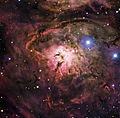Fichier:Lagoon Nebula.jpg

Taille de cet aperçu : 610 × 599 pixels. Autres résolutions : 244 × 240 pixels | 489 × 480 pixels | 782 × 768 pixels | 1 043 × 1 024 pixels | 1 841 × 1 808 pixels.
Fichier d’origine (1 841 × 1 808 pixels, taille du fichier : 2,92 Mio, type MIME : image/jpeg)
Historique du fichier
Cliquer sur une date et heure pour voir le fichier tel qu'il était à ce moment-là.
| Date et heure | Vignette | Dimensions | Utilisateur | Commentaire | |
|---|---|---|---|---|---|
| actuel | 4 mars 2014 à 02:20 |  | 1 841 × 1 808 (2,92 Mio) | Lmbuga | Putting the nebula in the center of the image |
| 9 août 2012 à 09:48 |  | 2 027 × 2 064 (1,59 Mio) | Fabian RRRR | higher resolution | |
| 22 avril 2010 à 09:32 |  | 1 280 × 1 303 (317 kio) | EricHS211 | {{Information |Description={{en|1=Infrared view of the Cat’s Paw Nebula (NGC 6334) taken by VISTA. NGC 6334 is a vast region of star formation about 5500 light-years from Earth in the constellation of Scorpius. The whole gas cloud is about 50 light-year |
Utilisation du fichier
Aucune page n’utilise ce fichier.
Usage global du fichier
Les autres wikis suivants utilisent ce fichier :
- Utilisation sur ady.wikipedia.org
- Utilisation sur alt.wikipedia.org
- Utilisation sur av.wikipedia.org
- Utilisation sur bn.wikipedia.org
- Utilisation sur cs.wikipedia.org
- Utilisation sur cv.wikipedia.org
- Utilisation sur de.wikipedia.org
- Utilisation sur en.wikipedia.org
- Utilisation sur et.wikipedia.org
- Utilisation sur fr.wikipedia.org
- Utilisation sur hu.wikipedia.org
- Utilisation sur kaa.wikipedia.org
- Utilisation sur kk.wikipedia.org
- Utilisation sur koi.wikipedia.org
- Utilisation sur ko.wikipedia.org
- Utilisation sur kv.wikipedia.org
- Utilisation sur lez.wikipedia.org
- Utilisation sur mdf.wikipedia.org
- Utilisation sur mg.wikipedia.org
- Utilisation sur mk.wikipedia.org
- Utilisation sur mrj.wikipedia.org
- Utilisation sur olo.wikipedia.org
- Utilisation sur os.wikipedia.org
- Utilisation sur pl.wikipedia.org
- Utilisation sur pt.wikipedia.org
- Utilisation sur ru.wikipedia.org
- Utilisation sur sah.wikipedia.org
- Utilisation sur sh.wikipedia.org
- Utilisation sur sk.wikipedia.org
Voir davantage sur l’utilisation globale de ce fichier.


